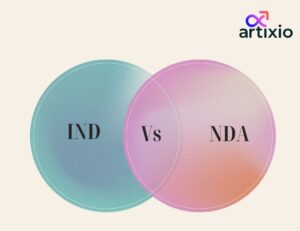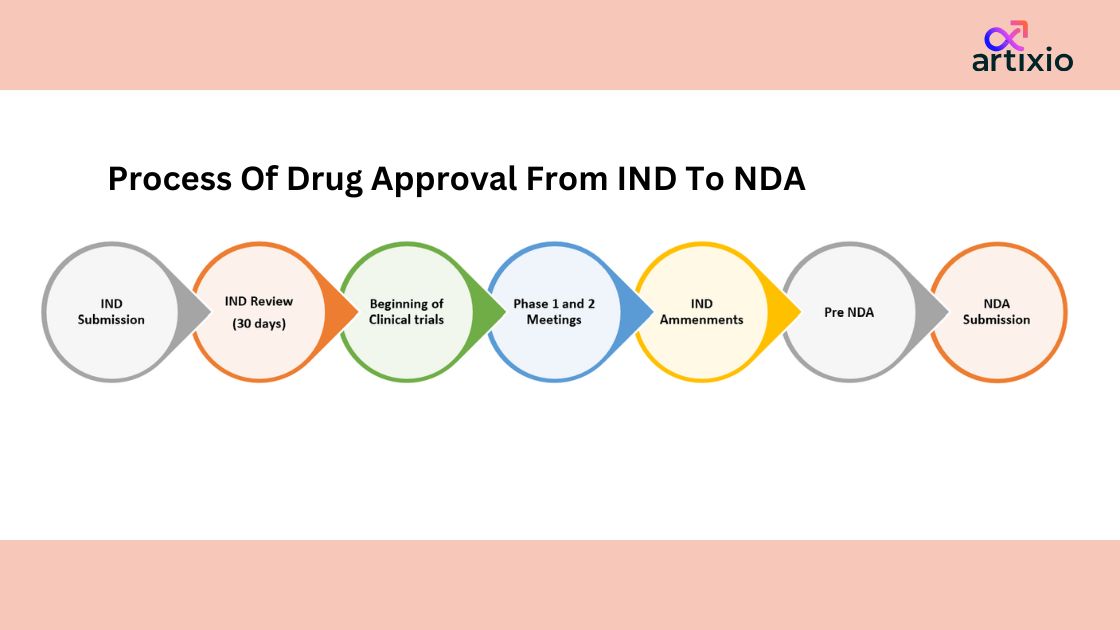Bringing a new drug to market in the U.S. isn’t a straight shot. Before a company can even think about selling it, the FDA wants proof at two different stages. First comes the IND — Investigational New Drug application. That’s basically the FDA’s way of saying, “Alright, you can test this in people now.” Later, after all those trials are done, the company files an NDA — New Drug Application, which is the FDA’s green or red light for marketing.
IND vs NDA difference is simple on the surface but critical in practice. IND is filed before clinical trials to show that the drug is safe enough to be tested in people. NDA is filed after trials to prove the drug works and can be approved for the market. Both play very different roles, yet one can’t happen without the other.
IND Vs NDA Comparison
Below is the detailed overview of IND and NDA which gives a broad understanding of the same.
Investigational New Drug Overview:
An IND, short for Investigational New Drug application, is the package a sponsor sends to the FDA when they want permission to move beyond lab work and try the drug in humans. It doesn’t grant marketing rights — it’s simply the go-ahead to begin clinical studies. It’s not market approval — it’s simply permission to run clinical trials. Once an IND is filed, the FDA has 30 days to review it. If no clinical hold is issued during that period, the sponsor can move forward with the trial. [You can read more in our detailed IND application guide →]
New Drug Application Overview:
After trials finish, companies submit an NDA to the FDA to request approval for marketing the drug. The NDA follows the eCTD format and contains data on safety, efficacy, labeling, and manufacturing.
The FDA review time varies: about 10 months for a standard review and around 6 months if priority review is granted. This step determines whether the drug can reach patients. [We’ve covered the NDA module process in detail →]
Also Read: Pharmaceutical Product Registration Services
Investigational New Drug Vs New Drug Application:
IND that is an investigational new drug, and NDA that is a new drug application, are great milestones in the drug development process. They both differ from each other at different stages which are explained below in the table:
| TITLE | IND | NDA |
| Submission Period | Submitted before clinical trials for approval from FDA. |
Submitted after IND approval for market access authorization by the FDA.
|
| Approval Period or Time | FDA takes 30 days to approve the IND application. | FDA takes 6-10 months to approve the IND application |
| Application Form | FDA website has form number 1571 for IND application submission. |
FDA website has form number 356h for NDA application submission
|
| Regulatory Focuses | IND focuses on safety, ethical considerations and investigator’s information. |
NDA focuses on safety, efficacy and labelling compliance of drugs product.
|
| Outcomes | IND approval leads to outcome of the initiation of clinical trials | NDA approval leads to the commercialization of drug products. |
| Regulatory Target | The regulatory bodies assure that the drug is safe for clinical trials |
The regulatory bodies assure us that the drug is effective for human use with appropriate labelling and marketing compliance.
|
| Required Data | Early clinical and Preclinical data. | Efficacy, safety and quality of drug product. |
| Post-Approval Responsibilities | Monitor clinical trials, report adverse effects, annual reports, etc. | Post-marketing surveillance, labelling changes if required. |
IND Vs NDA In Pharmacy: Key Differences
Submission Period:
The IND is submitted before the initiation of clinical trial to the FDA. The main purpose of IND is to provide all clinical trial protocols, investigator’s qualifications and drug safety information to check the safety of participants in clinical trials, whereas NDA is submitted in after the IND approval and completion of trials to get authorization for commercialization of drug product.
Review Period:
The review period for IND is usually 30 days where the FDA reviews the application and check all the mentioned aspects and decides to give approval or reject the application, on rejection the investigator needs to provide required data which is not found in the application for the approval purpose, whereas in case of NDA the FDA takes time of about 90 days to decide whether the application covers all the expected parameters, so if it should be reviewed or not. If the FDA decides to review the application, it takes a review time of about 9-12 months to grant approval or rejection to the NDA file.
Application form:
For IND filing, form number 1571 on the FDA website is required to be filed and the IND file needed to be attached, whereas in case of NDA form number 356h is required to be filled on the FDA website attaching the NDA document to the same.
Regulatory Focuses:
IND focuses on safety, ethical considerations and investigator’s information to ensure a safe initiation and continuation of clinical trial whereas NDA focuses on safety, efficacy and labelling compliance of drugs product for confirming all the parameters before market access.
Outcomes:
IND leads to the successful initiation of clinical trials upon approval by the FDA, whereas NDA results in authorization to commercialization of the drug product upon approval by the FDA.
Regulatory Target:
In IND the regulatory bodies assure us that the drug is safe for clinical trials whereas in NDA the regulatory bodies assure us that the drug is effective for human use with appropriate labelling and marketing compliance.
Required Data:
Early clinical and Preclinical data is required in IND whereas in NDA the data of efficacy, safety and quality of drug product is required.
Post-Approval Responsibilities:
To monitor clinical trials, report adverse effects, annual reports, etc. are some of the responsibilities of IND whereas post-marketing surveillance, labelling changes if required, etc. are some responsibilities of NDA.
IND vs NDA in Clinical Trials & Industrial Pharmacy
Think of the IND as a “green signal” for testing a new drug in people. Without it, no clinical trial can legally move forward. Regulators mainly want to see that patients will be safe and that the science behind the trial makes sense.
The NDA feels very different. By the time a company files it, years of clinical data, manufacturing controls, and safety results are already in hand. It’s basically saying: “We’ve tested this medicine enough — now let us sell it.”
From an industrial pharmacy angle, the two stages also shape very different kinds of work.
- When a team is working under an IND, the focus is on small trial batches, stability checks, and making sure the formulation is consistent enough for study use.
- By the time it reaches the NDA, the spotlight shifts to scaling up — bigger production, validated processes, packaging, labeling, and strict compliance with cGMP.
Simply,
- IND = scientific and regulatory bridge to start trials.
- NDA = industrial and regulatory bridge to launch the product.
Both steps are interlinked — one protects trial subjects, the other protects the wider public.
FAQs:
What is the difference between NDA and IND application?
NDA is submitted for marketing approval of drug products whereas IND is submitted for clinical trial approval to FDA.
Can an IND lead directly to an NDA?
Yes, a successful IND application can transition to submission of an NDA application for marketing approval.
What is the role of FDA in IND and NDA?
FDA plays the role of granting approval to sponsors for IND and NDA files.
What comes first IND or NDA?
IND is filed first for clinical trial initiation approval and then on completion of trials NDA is filed for marketing authorization of drug product.
To whom should the IND and NDA be submitted?
IND and NDA should be submitted to the FDA for approval.






